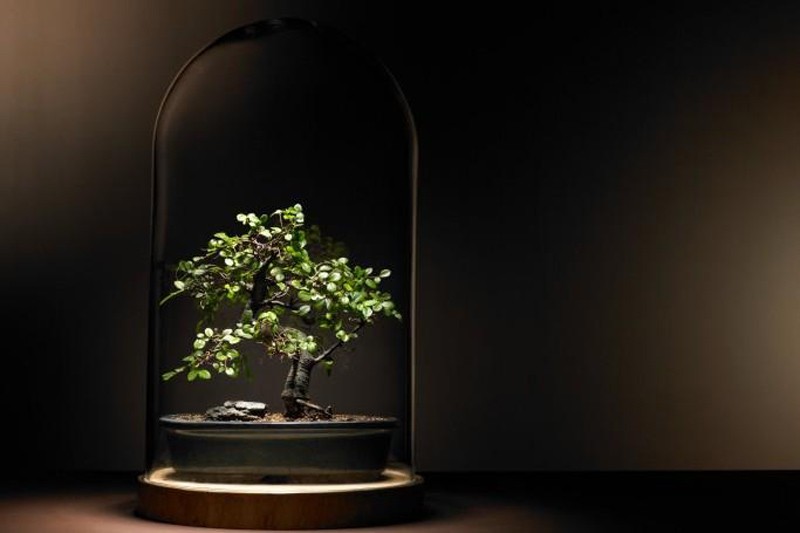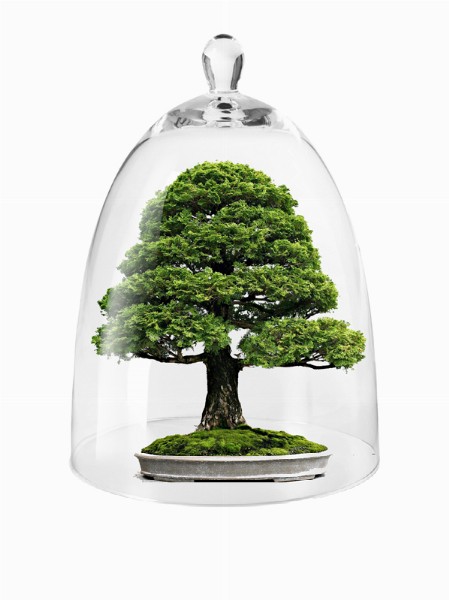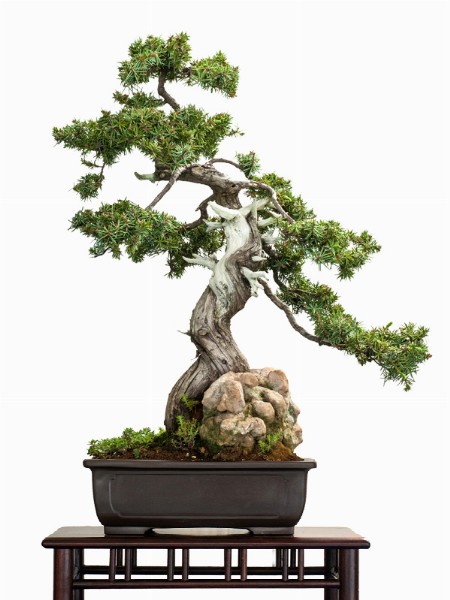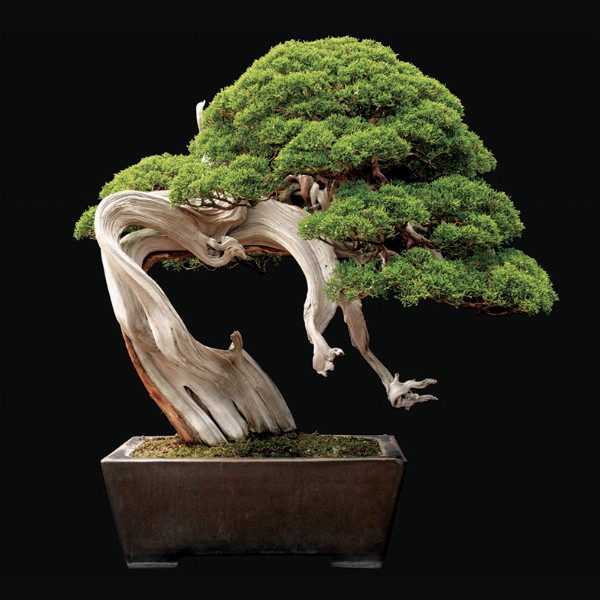The art of cultivating miniature plants goes back to China in the 15th century BCE, where they were called p’en - ts’ai, or landscapes in a vase. When the art reached Japan during the Kamakura period (1185-1333) it was given the name bonsai, meaning “to cultivate in a flat vase”. And it was in the country of the rising sun that the cultivation of miniature trees was perfected and refined to unimaginable levels. The first bonsai made its debut in Europe in 1878, where it graced the Paris Universal Exhibition, but only aroused tepid interest.
The years following the First World War saw a revival in interest, particularly in France and Britain, which in the meantime had seen the spread of Japanese gardens, somewhat modified by western fashions. Nowadays bonsais are fashionable everywhere, counting large numbers of enthusiasts and clubs all around the world, all linked by powerful new means of communication.
But as is so often the case, there are two sides to the issue, and the crowds of bonsai enthusiasts are matched by numbers of indignant opponents who are rooting for the tree.
These are all the people who wonder how a such an admirable people as the Japanese can foster an almost sadistic desire to see a tree – usually a fruit tree or a conifer – stunted and forced to survive in a matchbox-sized vase, while being constantly tortured by pruning and wiring to force it to grow into a specific shape. It is all too uncomfortably reminiscent of geishas having their “golden lotus flower” feet mutilated and bound.
Here instinct tends to take over and the miniature tree is freed from its imprisonment and planted to enjoy a lifetime of untrammelled liberty in the garden, thus easing the conscience of its erstwhile captor.
But what lies at the origins of these miniature trees? Despite being closely linked to Taoism and its magic-religious rites, it was in Japan that bonsai cultivation enjoyed its greatest success, growing into a fully-fledged discipline, on a par with the tea ceremony or the art of calligraphy. Ironically in Japan bonsais are considered the symbol of the beauties of natures. A different kind of beauty from the traditional western concept of harmonious forms, but rather the incarnation of nature and the marks inevitably left by the eternal flow of time. An old plum tree scarred by the passing seasons which still bears luxuriant green shoots every year may no longer boast the proud upstanding profile of its youth, but is still perfect in its imperfection. Which is why its trunk will be festooned with a sacred cord, a carved stone will be raised in dedication and offerings will be made to the divinity living in its gnarled bark. Bonsais incarnate the symbolism of trees’ longevity and man’s ability to recognise and appreciate their values.
Apparently the expert ministrations of Japanese bonsai gardeners are an elixir of long life to their miniature charges.
A bonsai gardener’s incessant care guarantees survival for many years more than might otherwise be the case in nature, where trees face a host a different dangers. But the trees must be pruned and thinned only by true experts, this is an art that requires infinite self-awareness in weighing choices and actions.
Given that we are not living in the Far East and that it would be extremely difficult to master all the experience and secrets of a Japanese expert in a short time span, barring a lengthily sojourn of several years in our beloved plant’s native land, the most sensible course of action would seem to be to follow the much simpler and more rational rules of plant physiology.
So what do the trees themselves think about all this?
Recent studies cite plant “awareness”: vegetable matter is aware of its environment, reacts to light and scent; is even able to distinguish between various different types of contact when touched.
Plants also have memories, in the sense that they “remember” previous illnesses or the repercussions of bad weather and can adapt by modifying its physiology according to those memories.
But plants are not aware of who’s looking after them: man is just one of the many external factors which help ensure their survival. Briefly, scientists claim that plants have no emotional life, so gardeners can only enjoy the same sort of relationship with them that children have with their imaginary playmates.
Apparently it is human beings who project their own emotional needs onto plants, and although plants interact with the environment surrounding them, they are not able to enjoy an emotional experience.
Pain, for example, requires complex neuronal connections to the cortex of the brain, found only in so-called higher vertebrates.
Basically plants cannot suffer because they don’t have brains.
In other words evolution has led us down different paths, providing man with an intelligence plants do not have: the ability to be interested in other things and look after them is a purely human prerogative. Unfortunately not all humans actually have this capacity; one of the reasons why more sensitive souls often prefer to talk and interact with plants.
We might even wonder what flowers and the nature around us see and think as we stroll through a garden; we might stop to give an affectionate stroke to the trunk of a splendid tree. The tree will know and remember that it has been touched, but it won’t remember us as the ones who touched. But we will remember a special moment in our lives. This is what science tells us and what we must inevitably bow to.
So although it might just be a question of projected emotions, many people simply can’t bear the sight of a dwarf tree confined to a box. And who shall say that we shouldn’t opt to plant a bonsai out in a large garden and give it an affectionate pat every now and again if it makes us happy, irrespective of whether plants can actually feel happiness and sadness or not?
Everyone knows that the purple light of dawn just before sunrise is caused by the refracted rays of the sun while it is still just below the horizon. But before science established it primacy as a discipline we were assured that Aurora, or dawn, was a goddess who drove her chariot across the skies scattering rose petals to announce the imminent arrival of the sun. “Pink-fingered Dawn” Homer called her. And because we belong to that category of “higher vertebrates” and possess the gifts of intelligence, illuminated, thanks to science, by an awareness of the reality surrounding us, we can afford to prefer one or the other version. Just as we can decide to free every bonsai we see trapped in its minute pot and restore it to its rightful freedom. After all, having an imaginary friend is no bad thing, is it?
The years following the First World War saw a revival in interest, particularly in France and Britain, which in the meantime had seen the spread of Japanese gardens, somewhat modified by western fashions. Nowadays bonsais are fashionable everywhere, counting large numbers of enthusiasts and clubs all around the world, all linked by powerful new means of communication.
But as is so often the case, there are two sides to the issue, and the crowds of bonsai enthusiasts are matched by numbers of indignant opponents who are rooting for the tree.
These are all the people who wonder how a such an admirable people as the Japanese can foster an almost sadistic desire to see a tree – usually a fruit tree or a conifer – stunted and forced to survive in a matchbox-sized vase, while being constantly tortured by pruning and wiring to force it to grow into a specific shape. It is all too uncomfortably reminiscent of geishas having their “golden lotus flower” feet mutilated and bound.
Here instinct tends to take over and the miniature tree is freed from its imprisonment and planted to enjoy a lifetime of untrammelled liberty in the garden, thus easing the conscience of its erstwhile captor.
But what lies at the origins of these miniature trees? Despite being closely linked to Taoism and its magic-religious rites, it was in Japan that bonsai cultivation enjoyed its greatest success, growing into a fully-fledged discipline, on a par with the tea ceremony or the art of calligraphy. Ironically in Japan bonsais are considered the symbol of the beauties of natures. A different kind of beauty from the traditional western concept of harmonious forms, but rather the incarnation of nature and the marks inevitably left by the eternal flow of time. An old plum tree scarred by the passing seasons which still bears luxuriant green shoots every year may no longer boast the proud upstanding profile of its youth, but is still perfect in its imperfection. Which is why its trunk will be festooned with a sacred cord, a carved stone will be raised in dedication and offerings will be made to the divinity living in its gnarled bark. Bonsais incarnate the symbolism of trees’ longevity and man’s ability to recognise and appreciate their values.
Apparently the expert ministrations of Japanese bonsai gardeners are an elixir of long life to their miniature charges.
A bonsai gardener’s incessant care guarantees survival for many years more than might otherwise be the case in nature, where trees face a host a different dangers. But the trees must be pruned and thinned only by true experts, this is an art that requires infinite self-awareness in weighing choices and actions.
Given that we are not living in the Far East and that it would be extremely difficult to master all the experience and secrets of a Japanese expert in a short time span, barring a lengthily sojourn of several years in our beloved plant’s native land, the most sensible course of action would seem to be to follow the much simpler and more rational rules of plant physiology.
So what do the trees themselves think about all this?
Recent studies cite plant “awareness”: vegetable matter is aware of its environment, reacts to light and scent; is even able to distinguish between various different types of contact when touched.
Plants also have memories, in the sense that they “remember” previous illnesses or the repercussions of bad weather and can adapt by modifying its physiology according to those memories.
But plants are not aware of who’s looking after them: man is just one of the many external factors which help ensure their survival. Briefly, scientists claim that plants have no emotional life, so gardeners can only enjoy the same sort of relationship with them that children have with their imaginary playmates.
Apparently it is human beings who project their own emotional needs onto plants, and although plants interact with the environment surrounding them, they are not able to enjoy an emotional experience.
Pain, for example, requires complex neuronal connections to the cortex of the brain, found only in so-called higher vertebrates.
Basically plants cannot suffer because they don’t have brains.
In other words evolution has led us down different paths, providing man with an intelligence plants do not have: the ability to be interested in other things and look after them is a purely human prerogative. Unfortunately not all humans actually have this capacity; one of the reasons why more sensitive souls often prefer to talk and interact with plants.
We might even wonder what flowers and the nature around us see and think as we stroll through a garden; we might stop to give an affectionate stroke to the trunk of a splendid tree. The tree will know and remember that it has been touched, but it won’t remember us as the ones who touched. But we will remember a special moment in our lives. This is what science tells us and what we must inevitably bow to.
So although it might just be a question of projected emotions, many people simply can’t bear the sight of a dwarf tree confined to a box. And who shall say that we shouldn’t opt to plant a bonsai out in a large garden and give it an affectionate pat every now and again if it makes us happy, irrespective of whether plants can actually feel happiness and sadness or not?
Everyone knows that the purple light of dawn just before sunrise is caused by the refracted rays of the sun while it is still just below the horizon. But before science established it primacy as a discipline we were assured that Aurora, or dawn, was a goddess who drove her chariot across the skies scattering rose petals to announce the imminent arrival of the sun. “Pink-fingered Dawn” Homer called her. And because we belong to that category of “higher vertebrates” and possess the gifts of intelligence, illuminated, thanks to science, by an awareness of the reality surrounding us, we can afford to prefer one or the other version. Just as we can decide to free every bonsai we see trapped in its minute pot and restore it to its rightful freedom. After all, having an imaginary friend is no bad thing, is it?












